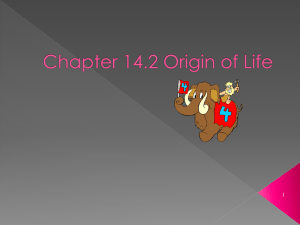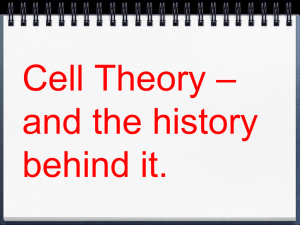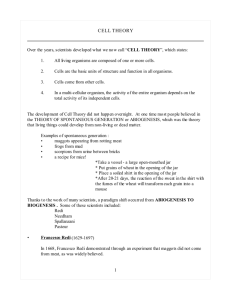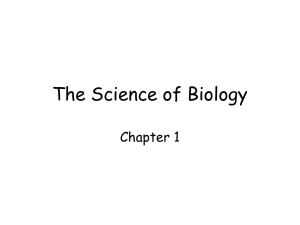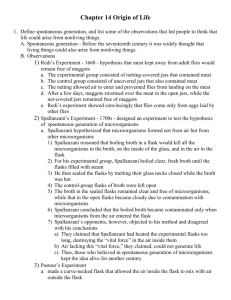Spontaneous Generation & Biogenesis Lesson
advertisement
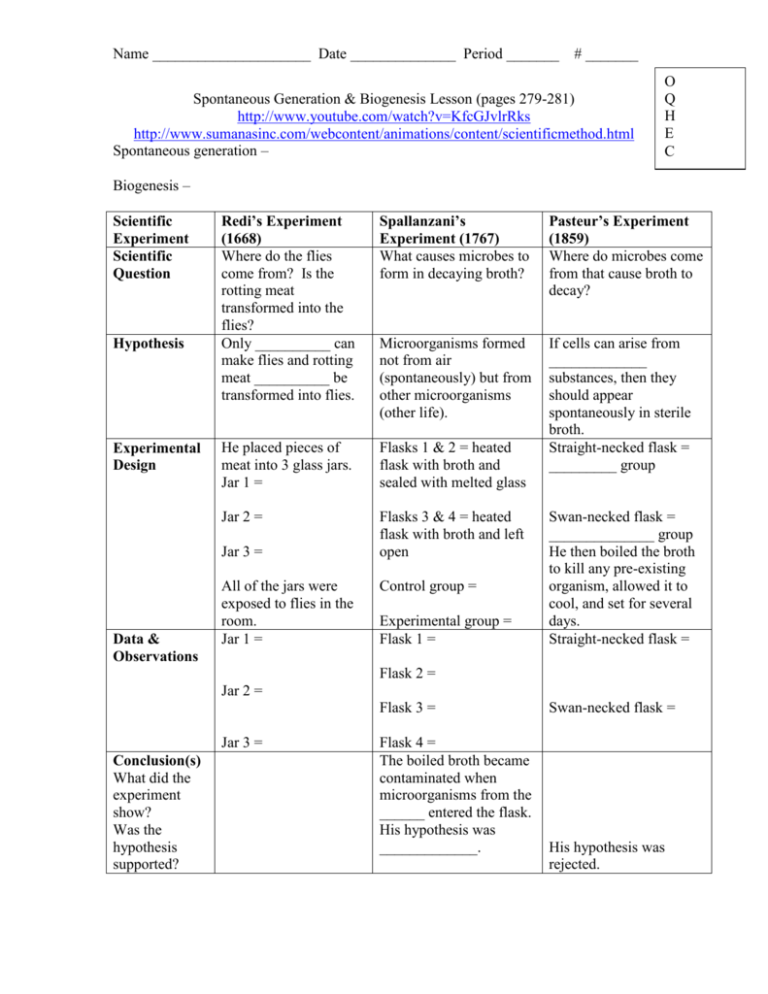
Name _____________________ Date ______________ Period _______ # _______ Spontaneous Generation & Biogenesis Lesson (pages 279-281) http://www.youtube.com/watch?v=KfcGJvlrRks http://www.sumanasinc.com/webcontent/animations/content/scientificmethod.html Spontaneous generation – O Q H E C Biogenesis – Scientific Experiment Scientific Question Hypothesis Experimental Design Redi’s Experiment (1668) Where do the flies come from? Is the rotting meat transformed into the flies? Only __________ can make flies and rotting meat __________ be transformed into flies. Spallanzani’s Experiment (1767) What causes microbes to form in decaying broth? Pasteur’s Experiment (1859) Where do microbes come from that cause broth to decay? Microorganisms formed not from air (spontaneously) but from other microorganisms (other life). He placed pieces of meat into 3 glass jars. Jar 1 = Flasks 1 & 2 = heated flask with broth and sealed with melted glass If cells can arise from _____________ substances, then they should appear spontaneously in sterile broth. Straight-necked flask = _________ group Jar 2 = Flasks 3 & 4 = heated flask with broth and left open Jar 3 = Data & Observations All of the jars were exposed to flies in the room. Jar 1 = Control group = Experimental group = Flask 1 = Swan-necked flask = ______________ group He then boiled the broth to kill any pre-existing organism, allowed it to cool, and set for several days. Straight-necked flask = Flask 2 = Jar 2 = Flask 3 = Jar 3 = Conclusion(s) What did the experiment show? Was the hypothesis supported? Flask 4 = The boiled broth became contaminated when microorganisms from the ______ entered the flask. His hypothesis was _____________. Swan-necked flask = His hypothesis was rejected. Name _____________________ Date ______________ Period _______ # _______ The Slow Death of Spontaneous Generation (1668-1859) Russell Levine and Chris Evers From the time of the ancient Romans, through the Middle Ages, and until the late nineteenth century, it was generally accepted that some life forms arose spontaneously from non-living matter. Such "spontaneous generation" appeared to occur primarily in decaying matter. For example, a seventeenth century recipe for the spontaneous production of mice required placing sweaty underwear and husks of wheat in an openmouthed jar, then waiting for about 21 days, during which time it was alleged that the sweat from the underwear would penetrate the husks of wheat, changing them into mice. Although such a concept may seem laughable today, it is consistent with the other widely held cultural and religious beliefs of the time. The first serious attack on the idea of spontaneous generation was made in 1668 by Francesco Redi, an Italian physician and poet. At that time, it was widely held that maggots arose spontaneously in rotting meat. Redi believed that maggots developed from eggs laid by flies. To test his hypothesis, he set out meat in a variety of flasks, some open to the air, some sealed completely, and others covered with gauze. As he had expected, maggots appeared only in the open flasks in which the flies could reach the meat and lay their eggs. This was one of the first examples of an experiment in the modern sense, in which controls are used. In spite of his well-executed experiment, the belief in spontaneous generation remained strong, and even Redi continued to believe it occurred under some circumstances. The invention of the microscope only served to enhance this belief. Microscopy revealed a whole new world of organisms that appeared to arise spontaneously. It was quickly learned that to create "animalcules," as the organisms were called, you needed only to place hay in water and wait a few days before examining your new creations under the microscope. The debate over spontaneous generation continued for centuries. In 1745, John Needham, an English clergyman, proposed what he considered the definitive experiment. Everyone knew that boiling killed microorganisms, so he proposed to test whether or not microorganisms appeared spontaneously after boiling. He boiled chicken broth, put it into a flask, sealed it, and waited - sure enough, microorganisms grew. Needham claimed victory for spontaneous generation. An Italian priest, Lazzaro Spallanzani, was not convinced, and he suggested that perhaps the microorganisms had entered the broth from the air after the broth was boiled, but before it was sealed. To test his theory, he modified Needham's experiment - he placed the chicken broth in a flask, sealed the flask, drew off the air to create a partial vacuum, then boiled the broth. No microorganisms grew. Proponents of spontaneous generation argued that Spallanzani had only proven that spontaneous generation could not occur without air. The theory of spontaneous generation was finally laid to rest in 1859 by the young French chemist, Louis Pasteur. The French Academy of Sciences sponsored a contest for the best experiment either proving or disproving spontaneous generation. Pasteur's winning experiment was a variation of the methods of Needham and Spallanzani. He boiled meat broth in a flask, heated the neck of the flask in a flame until it became pliable, and bent it into the shape of an S. Air could enter the flask, but airborne microorganisms could not - they would settle by gravity in the neck. As Pasteur had expected, no microorganisms grew. When Pasteur tilted the flask so that the broth reached the lowest point in the neck, where any airborne particles would have settled, the broth rapidly became cloudy with life. Pasteur had both refuted the theory of spontaneous generation and convincingly demonstrated that microorganisms are everywhere - even in the air.
